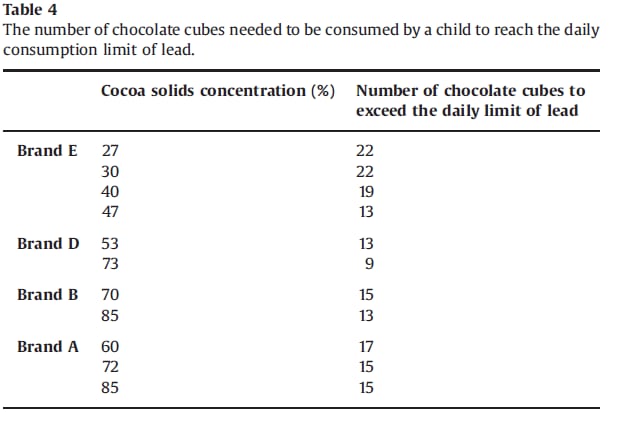Research by Yanus et al. assessing the human risk of trace metals in chocolate said that although the lead concentration found in a variety of global brands analyzed was below the US Pharmacopeia (USP) 1,000 ng/g limit, the lead concentration should, “still be considered a health concern”.
Risk exceeding daily limit
“Children, who are big consumers of chocolates, may be at risk of exceeding the daily limit of Pb [lead], due to their low body weight and higher digestive tract uptake,” said the Israeli researchers.
“They may be vulnerable to lead exposure from these products – one cube of dark chocolate can contain up to 20% of the lead oral limit; furthermore chocolate may not be the only source of lead in their nutrition thus increasing the risk of exceeding the daily limit.”
The same risk does not apply to adults, whose digestive absorption of metals is poor.
The more cocoa solids, the more lead
The research found a correlation between a high cocoa solid content and high levels of lead.
“In large quantities it is preferable for children to eat milk or white chocolates than eating dark chocolates [which have a higher cocoa solid concentration],” said the study.
Earlier research has shown that lead takes a long time to exit the body and in a short time can cause health problems in children including vomiting, constipation and weight loss as well as behavioural changes, slowed growth and memory and impaired language development.

Method
The researchers tested several unnamed chocolate bar brands from Europe, the US and Israel for eight trace elements: Lead, cadmium, chromium, manganese, cobalt, arsenic, bismuth and molybdenum.
They used inductively coupled plasma mass spectrometry (ICPMS), which the team described as “the method of choice” for determination of trace levels of heavy metals.
Bismuth and arsenic only in shells
Bismuth and arsenic were found in cocoa bean shells, but not in the cocoa bean itself and or the finished chocolate.
Cocoa beans are separated from the shell during the production process. The beans are processed to produce cocoa butter and cocoa powder which are used to manufacture chocolate.
Cocoa shells are often burnt for fuel at cocoa processing plants, but recent research has highlighted potential for using this waste material as a fiber and antioxidant-rich food ingredient.
Production increases presence of metals
The present researchers found that higher concentrations of lead, cadmium, chromium, manganese, cobalt and molybdenum in cocoa butter and powder than in the cocoa bean core.
“This indicates that most of the trace metal contaminations in these products are found after the beans are harvested, dried and shipped, namely during the manufacturing of cocoa and chocolate products.”
That correlates with earlier research by Rankin et al.
Dark chocolate contains more lead
Concentration of lead higher in dark chocolate (47-85% cocoa solids) than milk chocolate (27-30% cocoa solids)
Yanus et al. found there was no real risk from chromium in chocolate because the antioxidants in chocolate convert the toxic metal into a non-toxic element.
Balancing risks with benefits
The concentration of cobalt, cadmium, molybdenum in the chocolates analysed was well below USP oral limits leaving lead as the only real health concern, particularly for dark chocolate.
“These potential risks should be considered against the benefits of the antioxidant content and concentration of other components that contribute to health and wellbeing of consuming dark chocolate,” said the researchers.
Cocoa contains high quantities of phenolic phytochemicals known as flavanols (flavan-3-ols), which recent studies have linked to a series of benefits such as cardiovascular health, skin health, mood, brain health and cognition, and even reduced cancer risk.
Source:
Talanta 119 (2014) 1–4
http://dx.doi.org/10.1016/j.talanta.2013.10.048
‘Trace elements in cocoa solids and chocolate: An ICPMS study’
Authors : R.L. Yanus et al.
